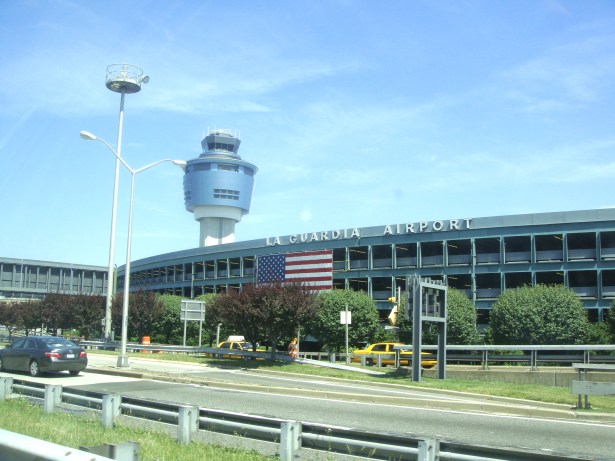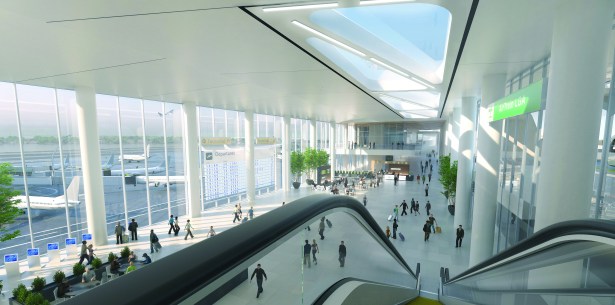The Head of LaGuardia Gateway Partners Breaks Down the Airport’s $4.2 Billion Facelift
By Terence Cullen July 27, 2016 10:15 am
reprints
For years, LaGuardia Airport has been compared to a “third-world country” because of its decrepit state, cramped corridors and subpar retail. But if you take a flight in or out of the northwestern Queens airport today, you’ll notice it has been upgraded to “developing nation” status—and, hopefully, yet another upgrade is on the horizon.
LaGuardia Gateway Partners—a consortium of six companies led by Vantage Airport Group, Meridiam and Skanska—officially entered its 35-year ground lease with the Port Authority of New York & New Jersey to build a new Terminal B, otherwise known as the central terminal building and home to airlines like JetBlue, Southwest and Air Canada. The existing facility, built more than 50 years ago and designed to hanger much fewer passengers than the 13.7 million travelers it did in 2015, will eventually be demolished.
The public-private partnership with the Port Authority is in the first step in building a new LaGuardia Airport that will be moved closer to the Grand Central Parkway. The $4.2 billion Terminal B project went through a rigorous selection and review process lasting more than two years, before the group closed on the deal this June. LaGuardia Gateway Partners will pay for the bulk of the project and make its money back through revenue from retail rents and airline fees. Delta Air Lines, which controls Terminals C and D, is planning its own part of the project. The group has received $2.5 billion in bond debt for the development, one of the largest issuances of its type.
A new parking garage is expected to open in 2018, and the main building will finish two years after that with most work done by 2022, according to the developers.
In the meantime, the building is housing makeshift offices for Stewart Steeves, the chief executive officer of LaGuardia Gateway Partners and an executive at Vantage Airport Group. His job includes working with the construction side of the consortium, including Skanska and Walsh Construction, as well as design firms HOK and Parsons-Brinkerhoff, along with the debt and future obligations.
Commercial Observer sat down with Steeves, 47 and a native of Toronto, in his office at LaGuardia to check on how the project is going. Steeves will be settling in New York in the coming weeks with his wife and three children. This isn’t his first airport job either. Steeves spent six years in Nassau, Bahamas, on a redevelopment of the city’s Lynden Pindling International Airport, which was completed in 2013.
Demolition work at the terminal’s crumbling garage will begin imminently, following the shutting down of it earlier this month (a few travelers still have to claim their cars). And on that footprint will eventually be the home of the new terminal.
What are your day-to-day responsibilities running the consortium?
I’m the chief executive officer of LaGuardia Gateway Partners. Within that, we have responsibilities for operations of the existing facility and eventually the new one. That involves all the customer actions: customer service, cleaning, facility maintenance and upkeep.
We’ve got significant financial responsibilities with the [$2.5 billion in] bonds that we’ve raised, as well as compliance with the Port Authority lease framework is a big part of it as well.
And, of course, there’s the project. Right now, that’s concluding the design phase, dealing with what we call the operational coordination—where aspects of the project start to touch the operating environment. And preserving the operational integrity of the facility, communicating to our stakeholders and our passengers and managing that interaction.
Eventually, [we’ll transition] a construction site into a live facility: training all of the people to use the facilities, testing, commissioning and moving from the old into the new. And having the passengers do the same thing. It’s a big exercise: One day at midnight we will close the old terminal, and the next morning at 4 a.m. when people start showing up for the first flights they will go to the new terminal. That’s a very exciting thing in the world of airport management.
Can you run us through how these six companies got together on the project?
It was basically four, almost five years ago when the procurement [of bids to redevelop] started to emerge as a possibility. That’s the time when we started talking to the partners and the consortium started to form so that we would be ready when the procurement got underway. It became a process of partnering both at the equity level and then with our design and construction partners as well.
Where are you in the construction phase since breaking ground earlier this year?
Our lease with the Port Authority officially began on June 1. When you walk the site today, what you see is the foundation work for the parking garage that’s forming on the west side of the site. And we see the early works beginning on the foundation for the central heating and refrigeration plant, which is on the east side of the site, near the Grand Central [Parkway].
Of course, the parking garage in front of the central terminal has been closed. Cars are slowly vacating that as they return from their travels. Shortly, the abatement work and the demolition work will begin on the parking garage to make way for the really substantial construction of the terminal.
So the main building will be where the garage is now? What will it include?
For outbound passengers, it will include check-in, security processing, the retail area, baggage screening. And then for inbound passengers, all the baggage claim and collection.
That really preserves the operation of the existing facility to the maximum extent possible while construction is going on.
And then other parts of the airport will be farther back?
It is within the ring road. Then we start constructing two island concourses. They will be essentially on what’s a vacant footprint. That will be constructed with very nominal impact on existing operations. Then, the special part of the design is that the [main building] and that island concourse will be connected by an elevated pedestrian bridge that will go right over the top of existing operations. That’s how we can construct both parts, while preserving operations of the existing facility.
The bridges go over the existing operations, but when we’re done, and the existing terminal is taken out, those bridges will actually go over aircraft maneuvering through the airport.
When will demolition of the current Terminal B building begin?
Substantially, this building only gets demolished once all the operations here have moved into the new head house. That’s in slightly less than four years time [from now].

Then the central hall comes into play, too. How important is that to the whole project?
It’s a central part in connecting the airport into a unified facility that’s consistent with Gov. [Andrew] Cuomo’s vision for LaGuardia Airport. It will really provide that connection point for what happens at Terminal B and what happens at the Delta facilities and act as that future junction point for the future AirTrain, perhaps other facilities. It has the potential to serve as the hub of LaGuardia Airport.
Do you do a lot of coordination with Delta?
It’s a tight site. What anybody does here affects everybody else. We’re closely coordinating with Delta and all the carriers in terms of the construction activity, the impact on the operations, the impact of our construction on their plans and their construction on our plans.
How is LaGuardia unique from anything you have ever worked on?
The unique challenge here is constructing on a very tight footprint. It’s a very busy airport with not a lot of real estate. We need to construct a new facility pretty much on top or over or alongside the existing operation while preserving the integrity of it both for the airlines and for passengers and the passenger experience.
What were your thoughts the first time you came through this airport and saw the way it is now?
It gets a bad rap. Deservedly so, in some respects. It’s a convenient airport in terms of the proximity to Manhattan. It’s a convenient airport in terms of the walking distances from aircraft to the taxis. But it’s vastly undersized for the number of people going through it. That restricts everything: the potential to put in world-class retail, amenities, food and beverage. It restricts the capacity of gates, so when there is congestion or delays, it gets overwhelmed.
Our intent is to preserve the convenient aspects of the airport. Clearly, it’s already close to Manhattan; we’re not changing any part of the physical proximity [from Manhattan]. But in terms of the convenience, in terms of the curb-to-gate experience for the passenger, we want to preserve that while also opening up the capacity so it can truly be a world-class facility in terms of amenities, food and beverage, service offerings, retail.
Going to an airport has become experiential like going to a baseball game: You go to the store, you get your food and then you go to the main attraction. Being an airport developer, how has that become so important over time?
An airport is not just about the facility; it’s about the experience the passenger has in the facility. Of course the facility is the backdrop of that, but then really it’s what happens within in terms of what are the services, what are the amenities, what’s the relationship we form with the passenger through technology or other means to inform them and make sure they have what they need and what they want in their journey.
Your baseball analogy: We start to win when people make a conscious choice to come to the airport earlier than they may have otherwise because they make it part of the destination in their trip. They choose to come out to have dinner at a restaurant before their flight. Or they choose to come out early because there’s shopping they prefer to do.
Our objective is to appeal to passengers when they arrive but also get passengers to make a conscious choice and make them aware of what’s possible so that they can choose to do that as part of their journey.

How did you get into the airport development business?
It’s really a combination of my passions: capital projects, financing and aviation. I’m an engineer, a financial professional and I’ve been a pilot for 20 years. That combination led me to this industry. What’s kept me here is the diversity and complexity of the business and all its attributes. From operations, to retail, to enhancing the experience for all our customers, whether they are passengers or airlines.
What was it like building an airport in Nassau?
It was a commercial project, sure, but more importantly it was a real opportunity to make a difference for the people and the country. It was the largest infrastructure project in the country’s history by a wide margin. And it was taking place in a time of economic turmoil. There were no established precedents for how we were going to bring this project to fruition—and all with private financing.
What are you and your family looking forward to about moving to New York?
Personally, I’ve been living mostly in New York for the past couple of years. Now that the deal is done, my family is coming to join me in a couple of weeks in time for the kids to start school. We’re all looking forward to being together in such a diverse, global city. The city and state have so much to offer: culture, the arts, outdoor activities and, of course, big team sports.


